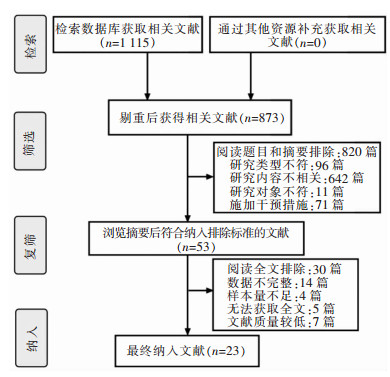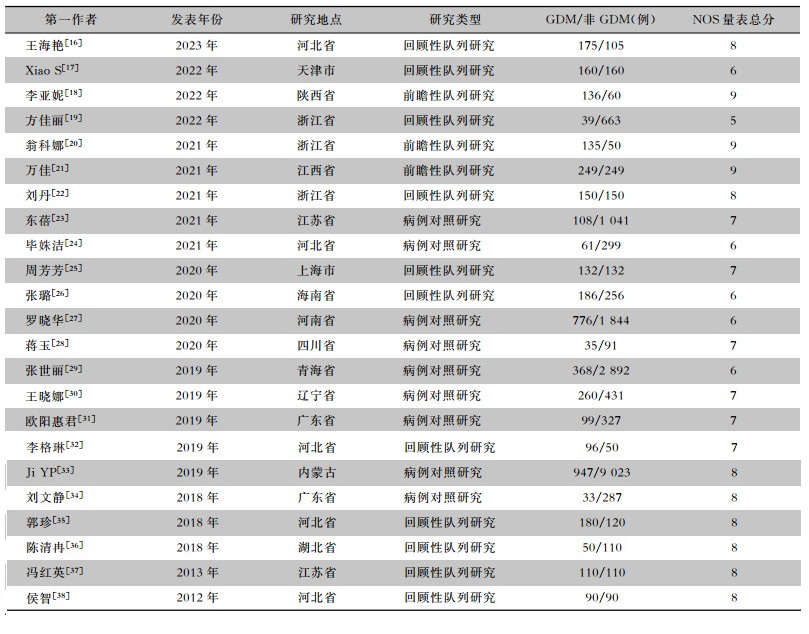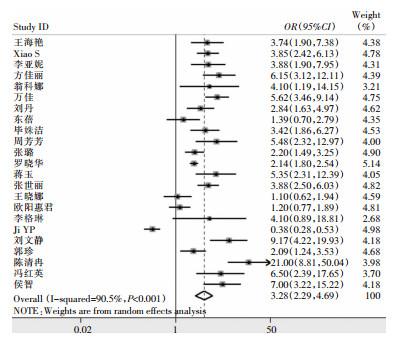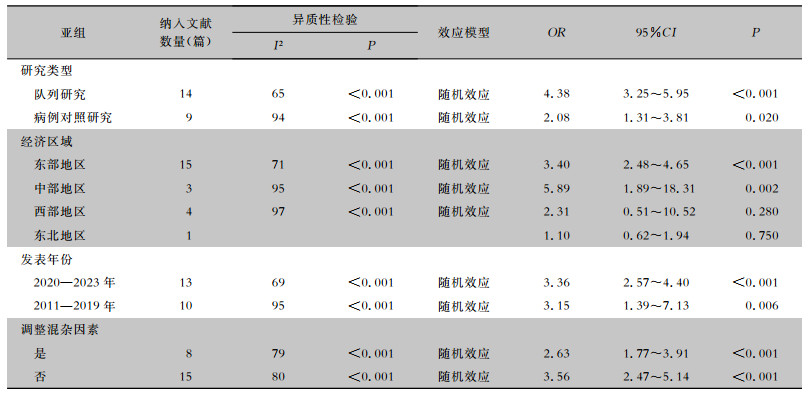2. 中南大学湘雅医院医院感染控制中心, 湖南 长沙 410008
2. Center for Healthcare-associated Infection Control, Xiangya Hospital, Central South University, Changsha 410008, China
妊娠期糖尿病(gestational diabetes mellitus, GDM)是指妊娠期间首次出现的不同程度的糖耐量受损[1],是妊娠期最常见的合并症之一。近年来,随着人们生活水平的提升和生育政策的开放,GDM的发生率也呈逐年上升趋势,2021年全球范围内GDM患病率为14.0%[2],我国GDM患病率已高达14.8%[3]。GDM作为一种代谢性疾病,发病机制与2型糖尿病存在着许多相似之处,主要与胰岛素抵抗及胰岛β细胞分泌功能降低有关[4-5],但其具体发病机制仍未完全阐明。GDM对阴道菌群、围产结局乃至新生儿近、远期健康均有重要影响,同时也增加了社会的医疗经济负担,GDM已成为亟待解决的公共卫生问题之一。
微生物群落在人类健康与疾病中起着重要作用。一般情况下,女性阴道存在多种微生物,与宿主和环境之间形成“三角关系”,共同稳固阴道微生态。自妊娠初期起,孕妇生殖道菌群逐渐转换为以稳定的高丰度乳杆菌、低多样性为主的菌群特征,并持续至整个孕期,直至分娩后,又逐渐恢复为妊娠前结构特征[6-7],GDM孕妇因胰岛素抵抗、糖原堆积,阴道组织中高血糖环境利于作为优势菌的乳酸杆菌以外的其他细菌滋生,引起阴道微生物群的紊乱,从而引发生殖道感染。妊娠期发生下生殖道感染是胎膜早破、自发流产、自发早产及母儿感染等不良预后的高危因素[8-12]。
目前关于GDM与生殖道感染的相关研究较多,但研究各自独立,结论不明确或不一致。与非GDM孕妇相比,GDM是否是生殖道感染的高危因素,目前尚无统一定论且缺乏循证依据。因此,本研究通过全面检索GDM和生殖道感染的相关文献,采用Meta分析的方法,探讨GDM与生殖道感染发生风险的关系。
1 资料与方法 1.1 文献检索策略通过中国知网、万方数据知识服务平台、维普中文期刊数据库、中国生物医学文献、PubMed、Embase、Web of Science、The Cochrane Library等中英文数据库检索文献,检索从建库至2023年5月23日公开发表的GDM与生殖道感染有关的研究。中文检索词主要为“妊娠期糖尿病”“妊娠糖尿病”“生殖道感染”“微生物”,英文检索词包括:“diabetes, gestational”“diabetes, pregnancy-induced”“pregnancy-induced diabetes”“gestational diabetes”“diabetes mellitus, gestational”“gestational diabetes mellitus”“GDM”“reproductive tract infections”“infections reproductive tract”“genital tract infections”“infections, genital tract”“germ microbe microorganism”。采用自由词与主题词结合的检索方式,以及人工检索纳入文献的参考文献列表,由两位研究人员独立完成整个检索过程。
1.2 文献纳入与排除标准纳入标准:(1)各数据库从建库至2023年5月23日以中、英文形式已公开发表的有关GDM人群生殖道感染的原创性研究。(2)原始研究类型为病例对照研究或队列研究。(3)GDM的诊断标准符合《妊娠合并糖尿病诊治指南(2014)》[13];生殖道感染的诊断方法及标准符合9版《妇产科学》[14]。(4)文中直接描述GDM孕妇生殖道感染的发生率或可获取计算生殖道感染发生率的数据。(5)研究对象为中国人群。排除标准:(1)出版物类型为综述、评论、会议摘要、会议记录、病例报告、书籍章节等。(2)GDM孕妇和非GDM孕妇样本量不足30例。(3)文献质量较低、信息不完整、数据不充分、无法提取数据的文献。(4)重复发表的文献。
1.3 文献数据提取与质量评价将检索获得的文献导入文献管理软件Endnote X9进行剔重,由两名研究人员通过独立阅读题目及摘要进行初筛,删除与研究主题不相关的文献,然后下载全文进行进一步筛选;意见不统一时,可由第三位研究人员参与讨论后协商解决。提取资料的信息包括:文献的第一作者、发表年份、开展调查的地区、研究设计类型、GDM孕妇/非GDM孕妇的样本量、感染人数等相关信息。本研究根据纽卡斯尔-渥太华量表(Newcastle-Ottawa Scale, NOS)[15]进行文献质量评估。该量表包括研究人群选择、组间可比性以及结果测量三个方面共8个条目,满分为9分,评分6分以上为高质量文献。由2名研究人员独立评价纳入研究的文献质量,并交叉核对结果。若有意见不一致则通过讨论或与第3位研究人员协商解决。
1.4 统计学处理使用Stata 14.0软件进行Meta分析,采用比值比(odds ratio, OR)及其95%置信区间(95% confidence interval, 95%CI)评价GDM与生殖道感染之间的相关性。根据Cochran’s Q检验和I2值(异质性系数)判断纳入文献间是否存在异质性及其大小。当Q检验P≥0.05,I2≤50%时,表明各研究间异质性较低,采用固定效应模型进行分析;当Q检验P<0.05,I2>50%时,则表明各研究间存在较大的异质性,采用随机效应模型进行分析。通过亚组分析和敏感性分析探索异质性的来源,敏感性分析采用逐一排除各研究的方法评估结果的稳健性,利用漏斗图结合Egger’s线性回归法评价发表偏倚。P≤0.05为差异有统计学意义。
2 结果 2.1 文献纳入流程根据制定的检索策略,初步检索到文献1 115篇,中、英文文献分别为860、255篇。采用Endnote X9软件查重后排除重复文献242篇;通过阅读题目、摘要后排除研究类型不符或未涉及GDM孕妇生殖道感染的发生情况或研究对象为非中国孕妇的或在研究过程中施加干预措施的文献820篇;阅读全文后排除文献30篇,最终纳入文献23篇。见图 1。
 |
| 图 1 GDM与生殖道感染关系Meta分析的文献筛选流程图 Figure 1 Flow diagram of literature screening for Meta-analysis on the relationship between GDM and reproductive tract infection |
最终纳入23篇文献,其中包括英文文献2篇,中文文献21篇,共计GDM孕妇4 575例,非GDM孕妇18 540例。文献发表时间为2012—2023年,其中2012—2019年10篇,2020—2023年13篇;研究设计类型为队列研究和病例对照研究,其中队列研究14篇,病例对照研究9篇;研究地点:东部地区(天津市、河北省、上海市、江苏省、浙江省、广东省、海南省)15篇,中部地区(江西省、河南省、湖北省)3篇,西部地区(内蒙古自治区、四川省、陕西省、青海省)4篇,东北地区(辽宁省)1篇。纳入的23篇文献NOS评分在5~9分,其中评分>6分有17篇。见表 1。
| 表 1 GDM与生殖道感染关系Meta分析纳入文献的基本特征 Table 1 Basic characteristics of the included literatures in Meta-analysis on the relationship between GDM and reproductive tract infection |

|
对纳入的23篇文献进行异质性检验,结果显示I2=90.5%(P<0.001),逐一剔除文献后发现,各研究间异质性仍较大,故采用随机效应模型进行Meta分析。Meta分析显示,GDM孕妇组生殖道感染的发生率与非GDM孕妇组比较,差异具有统计学意义(OR=3.28,95%CI:2.29~4.69,P<0.001),提示GDM是生殖道感染的高危因素。见图 2。
 |
| 图 2 GDM与生殖道感染关系的Meta分析森林图 Figure 2 Forest plot of Meta-analysis on the relationship between GDM and reproductive tract infection |
按照研究类型、经济区域、发表年份及是否调整混杂因素进行亚组分析,结果显示,不同研究类型、不同发表年份和是否调整混杂因素的合并效应均表明GDM是生殖道感染的危险因素(均P<0.05);对于不同经济区域,东部地区和中部地区合并效应均表明GDM是生殖道感染的危险因素(均P<0.05),而西部地区和东北地区尚不能确定GDM是生殖道感染的危险因素(均P>0.05)。见表 2。
| 表 2 GDM人群与生殖道感染关系亚组Meta分析 Table 2 Subgroup Meta-analysis on the relationship between GDM population and reproductive tract infection |

|
对纳入的23篇文献采用漏斗图结合Egger’s线性回归法评估发表偏倚情况,结果显示漏斗图为非对称(见图 3),Egger’s线性回归检验P=0.030,存在一定的发表偏倚。采用逐一排除文献的方法进行敏感性分析,合并效应值均无明显变化,敏感性分析显示本研究结果较稳定可靠,见图 4。
 |
| 图 3 GDM与生殖道感染关系Meta分析纳入文献发表偏倚漏斗图 Figure 3 Funnel plots of publication bias of the included literatures in Meta-analysis on the relationship between GDM and reproductive tract infection |
 |
| 图 4 GDM与生殖道感染关系Meta分析纳入文献敏感性分析结果 Figure 4 Sensitivity analysis results of the included literatures in Meta-analysis on the relationship between GDM and reproductive tract infection |
GDM是妊娠期特有的糖代谢异常疾病[39],GDM孕妇在妊娠期间可无明显临床症状,但由于GDM孕妇体内糖代谢紊乱会导致细胞和体液免疫功能不同程度的受损,免疫功能的降低以及高糖的浸润增加了个体对生殖道感染的敏感性[34]。生殖道感染可通过激活免疫系统,诱导白细胞介素(IL)-1β、IL-6、IL-8及肿瘤坏死因子(TNF)-α等炎症介质的产生,引起前列腺素释放,促进子宫收缩和宫颈成熟,引起流产、早产等不良妊娠结局[40-42]。因此,妊娠期生殖道感染的筛查处理一直是临床工作中备受重视的问题,感染高危人群的判断甄别、早期筛查和治疗生殖道感染是改善妊娠结局的重要措施之一。
目前研究[43]表明,在非孕妇女中糖尿病及较差的血糖控制是生殖道感染的独立危险因素,其具体机制未明,可能是因为机体中糖原、雌激素碳水化合物等含量的升高,促进了特定微生物的适应性生长。荷兰一项纳入孕12~13周妊娠妇女的前瞻性研究Meta分析[44]中,多数研究肯定了妊娠合并糖尿病与生殖道感染的关系。阴道组织中高血糖环境会吸引真菌的附着并促进真菌成长;此外,10~11 mmol/L的血糖作为“蚁穴效应”攻击机体防御屏障,高血糖可以使得中性粒细胞产生“迷失效应”,即其对炎症因子吸引作用减弱,攻击性降低,增加致病菌入侵GDM患者机体的概率,进而导致阴道菌群微生态失衡[45]。GDM可影响孕妇阴道菌群密集度与多样性、乳酸杆菌强度及病原微生物等[25]。但仍有部分研究[46-48]认为,妊娠合并糖尿病的孕妇生殖道感染的发病风险与非糖尿病的孕妇并无明显差异。本Meta分析结果显示,GDM孕妇组生殖道感染的发生率与非GDM孕妇组比较,差异具有统计学意义(OR=3.28,95%CI: 2.29~4.69,P<0.001),确定了GDM是生殖道感染的危险因素,与已有研究[44]结果相符,但纳入分析的各研究间存在较高异质性。为分析导致异质性的潜在影响因素,我们根据研究类型、经济区域、发表年份及是否调整混杂因素进行亚组分析,结果显示不同研究类型、不同发表年份和是否调整混杂因素的合并效应均表明GDM是生殖道感染的危险因素;对于不同经济区域,东部地区和中部地区合并效应均表明GDM是生殖道感染的危险因素,而西部地区和东北地区尚不能确定GDM是生殖道感染的危险因素,其原因可能是因为不同地区对围生保健重视度、生殖道感染高危孕妇监测及早期感染防控措施等行为不一样,提示非常有必要对GDM孕妇进行生殖道感染的筛查及定期监测。同时医护人员需对GDM患者进行个体化的指导及跟踪,控制孕妇体重,改善高血糖状态,将孕妇血糖水平控制在正常范围内,以预防妊娠期生殖道感染的发生,降低发生不良妊娠结局的风险。
本研究的局限性:(1)本次纳入文献的原始研究类型为病例对照研究或队列研究,由于该研究类型在研究设计上的限制,可能存在选择性偏倚和回忆偏倚等各类偏倚。(2)本次纳入的文献中调整混杂因素各不相同,部分研究未调整任何混杂因素,结果的准确性可能会受到影响。(3)本Meta分析纳入的研究间存在较大的异质性,但由于受原始资料的限制,没有进行更详细的亚组分析,目前的结果无法完全解释异质性的来源。
综上所述,当前研究证据表明,GDM与生殖道感染的发生风险存在正相关性,GDM是生殖道感染发生的高危因素,医务人员应提前告知GDM孕妇其妊娠过程中可能存在的额外风险,以便对母体及胎儿进行更密切的监测;同时,在临床工作中应当重视妊娠期生殖道感染高危人群的判断甄别、早期筛查和监测,将有助于良好的围产结局。
利益冲突:所有作者均声明不存在利益冲突。
| [1] |
Johns EC, Denison FC, Norman JE, et al. Gestational diabetes mellitus: mechanisms, treatment, and complications[J]. Trends Endocrinol Metab, 2018, 29(11): 743-754. DOI:10.1016/j.tem.2018.09.004 |
| [2] |
Wang H, Li NH, Chivese T, et al. IDF diabetes atlas: estimation of global and regional gestational diabetes mellitus prevalence for 2021 by international association of diabetes in pregnancy study group's criteria[J]. Diabetes Res Clin Pract, 2022, 183: 109050. DOI:10.1016/j.diabres.2021.109050 |
| [3] |
Gao CH, Sun X, Lu L, et al. Prevalence of gestational diabetes mellitus in mainland China: a systematic review and Meta-analysis[J]. J Diabetes Investig, 2019, 10(1): 154-162. DOI:10.1111/jdi.12854 |
| [4] |
Zhu YY, Mendola P, Albert PS, et al. Insulin-like growth factor axis and gestational diabetes mellitus: a longitudinal study in a multiracial cohort[J]. Diabetes, 2016, 65(11): 3495-3504. DOI:10.2337/db16-0514 |
| [5] |
Harreiter J, Simmons D, Desoye G, et al. IADPSG and WHO 2013 gestational diabetes mellitus criteria identify obese women with marked insulin resistance in early pregnancy[J]. Diabetes Care, 2016, 39(7): e90-e92. DOI:10.2337/dc16-0200 |
| [6] |
Greenbaum S, Greenbaum G, Moran-Gilad J, et al. Ecological dynamics of the vaginal microbiome in relation to health and disease[J]. Am J Obstet Gynecol, 2019, 220(4): 324-335. DOI:10.1016/j.ajog.2018.11.1089 |
| [7] |
Nunn KL, Witkin SS, Schneider GM, et al. Changes in the vaginal microbiome during the pregnancy to postpartum transition[J]. Reprod Sci, 2021, 28(7): 1996-2005. DOI:10.1007/s43032-020-00438-6 |
| [8] |
Reekie J, Roberts C, Preen D, et al. Chlamydia trachomatis and the risk of spontaneous preterm birth, babies who are born small for gestational age, and stillbirth: a population-based cohort study[J]. Lancet Infect Dis, 2018, 18(4): 452-460. DOI:10.1016/S1473-3099(18)30045-8 |
| [9] |
Adamson PC, Klausner JD. Treating chlamydial infections in pregnancy and preventing adverse birth outcomes[J]. Lancet Infect Dis, 2018, 18(4): 368-369. DOI:10.1016/S1473-3099(18)30049-5 |
| [10] |
Brabant G. Bacterial vaginosis and spontaneous preterm birth[J]. J Gynecol Obstet Biol Reprod (Paris), 2016, 45(10): 1247-1260. DOI:10.1016/j.jgyn.2016.09.014 |
| [11] |
Işik G, Demirezen Ş, Dönmez HG, et al. Bacterial vaginosis in association with spontaneous abortion and recurrent pregnancy losses[J]. J Cytol, 2016, 33(3): 135-140. DOI:10.4103/0970-9371.188050 |
| [12] |
陈翠红. 足月胎膜早破产妇的影响因素及其对妊娠结局的影响[J]. 中国妇幼保健, 2016, 31(19): 3949-3951. Chen CH. Factors affecting women with preterm rupture of membranes at term and their impact on pregnancy outcome[J]. Maternal and Child Health Care of China, 2016, 31(19): 3949-3951. |
| [13] |
中华医学会妇产科学分会产科学组, 中华医学会围产医学分会妊娠合并糖尿病协作组. 妊娠合并糖尿病诊治指南(2014)[J]. 中华妇产科杂志, 2014, 49(8): 561-569. Obstetrics Subgroup, Chinese Society of Obstetrics and Gynecology, Chinese Medical Association, Group of Pregnancy with Diabetes Mellitus, Chinese Society of Perinatal Medicine, Chinese Medical Association. Guidelines for the diagnosis and treatment of gestational diabetes mellitus (2014)[J]. Chinese Journal of Obstetrics and Gynecology, 2014, 49(8): 561-569. |
| [14] |
谢幸, 孔北华, 段涛. 妇产科学[M]. 9版. 北京: 人民卫生出版社, 2018: 238. Xie X, Kong BH, Duan T. Obstetrics and gynecology[M]. 9th ed. Beijing: People's Medical Publishing House, 2018: 238. |
| [15] |
Stang A. Critical evaluation of the Newcastle-Ottawa scale for the assessment of the quality of nonrandomized studies in Meta-analyses[J]. Eur J Epidemiol, 2010, 25(9): 603-605. DOI:10.1007/s10654-010-9491-z |
| [16] |
王海艳, 郭艳巍, 杨佳琦, 等. Nrf2基因启动子多态性与妊娠期糖尿病合并生殖道感染PROM易感性的关联[J]. 中华医院感染学杂志, 2023, 33(6): 904-909. Wang HY, Guo YW, Yang JQ, et al. Association of Nrf2 gene promoter polymorphism with susceptibility to PROM in gestational diabetes mellitus patients complicated with genital tract infection[J]. Chinese Journal of Nosocomiology, 2023, 33(6): 904-909. |
| [17] |
Xiao S, Zhang QQ, Zhang M, et al. Changes of vaginal microecology of pregnant women with gestational diabetes mellitus[J]. Int J Gynaecol Obstet, 2023, 160(3): 1043-1045. DOI:10.1002/ijgo.14523 |
| [18] |
李亚妮, 肖景华, 计静, 等. 妊娠期糖尿病患者孕晚期阴道微生态状况、血清网膜素、促代谢因子水平变化及临床意义[J]. 陕西医学杂志, 2022, 51(11): 1372-1375, 1380. Li YN, Xiao JH, Ji J, et al. Changes and significance of vaginal microecological status and levels of serum omentin and β-trophin in late pregnancy of patients with gestational diabetes mellitus[J]. Shaanxi Medical Journal, 2022, 51(11): 1372-1375, 1380. |
| [19] |
方佳丽, 秦家利, 杨佳. 围生期孕妇生殖道感染病原菌分布妊娠结局及风险因素分析[J]. 中国妇幼保健, 2022, 37(21): 3987-3991. Fang JL, Qin JL, Yang J. Distribution of pathogenic bacteria in perinatal pregnant women with reproductive tract infections: analysis of pregnancy outcomes and risk factors[J]. Maternal and Child Health Care of China, 2022, 37(21): 3987-3991. |
| [20] |
翁科娜, 李璐, 张洁琼, 等. 妊娠期糖尿病合并生殖道感染危险因素及其免疫状态[J]. 中华医院感染学杂志, 2021, 31(6): 910-914. Weng KN, Li L, Zhang JQ, et al. Risk factors for genital tract infection in patients with gestational diabetes mellitus and immune status[J]. Chinese Journal of Nosocomiology, 2021, 31(6): 910-914. |
| [21] |
万佳. 妊娠期糖尿病阴道微生态失衡与绒毛膜羊膜炎的相关性研究[D]. 南昌: 南昌大学, 2021. Wan J. Study on the relationship between vaginal microecologi-cal imbalance and chorioamnionitis in gestational diabetes mellitus pregnant women[D]. Nanchang: Nanchang University, 2021. |
| [22] |
刘丹, 李敏. 妊娠期糖尿病产妇妊娠晚期阴道微生态改变与围产结局的相关性分析[J]. 中国微生态学杂志, 2021, 33(5): 577-580. Liu D, Li M. Correlation analysis of vaginal microecology changes and perinatal outcome in the third trimester of gestational diabetes mellitus[J]. Chinese Journal of Microecology, 2021, 33(5): 577-580. |
| [23] |
东蓓, 周素芳, 张璇. 晚孕期孕妇生殖道B族链球菌感染对母儿结局的影响[J]. 中华妇幼临床医学杂志(电子版), 2021, 17(3): 347-354. Dong B, Zhou SF, Zhang X. Effect of group B Streptococcus infection in genital tract of pregnant women in third trimester on maternal and infant outcomes[J]. Chinese Journal of Obstetrics & Gynecology and Pediatrics(Electronic Edition), 2021, 17(3): 347-354. |
| [24] |
毕姝洁, 孙君侠, 王冬梅, 等. 围产期孕妇生殖道感染的影响因素分析[J]. 中国病案, 2021, 22(11): 97-99. Bi SJ, Sun JX, Wang DM, et al. Analysis of influencing factors of genital tract infection in perinatal pregnant women[J]. Chinese Medical Record, 2021, 22(11): 97-99. |
| [25] |
周芳芳, 史娜娜. 妊娠期糖尿病孕妇阴道微生态变化及其对妊娠结局的影响[J]. 中华妇幼临床医学杂志(电子版), 2020, 16(6): 714-719. Zhou FF, Shi NN. Vaginal microecological changes of gestational diabetes mellitus pregnant women and its influence on pregnancy outcomes[J]. Chinese Journal of Obstetrics & Gynecology and Pediatrics(Electronic Edition), 2020, 16(6): 714-719. |
| [26] |
张璐, 徐佳佳. 妊娠期糖尿病孕妇妊娠中晚期阴道微生态特点分析[J]. 中国生育健康杂志, 2020, 31(1): 53-54, 59. Zhang L, Xu JJ. Analysis of vaginal microecological characteri-stics of pregnant women with gestational diabetes mellitus in the middle and late stages of pregnancy[J]. Chinese Journal of Reproductive Health, 2020, 31(1): 53-54, 59. |
| [27] |
罗晓华, 史娜, 郭晓珮, 等. 妊娠期B族链球菌带菌情况危险因素及母婴结局的临床研究[J]. 中国妇产科临床杂志, 2020, 21(4): 399-401. Luo XH, Shi N, Guo XP, et al. Clinical study on the pregnancy outcome and the risk factors of group B Streptococcus germ carrying during pregnancy[J]. Chinese Journal of Clinical Obstetrics and Gynecology, 2020, 21(4): 399-401. |
| [28] |
蒋玉, 潘珂, 尚志容, 等. 妊娠晚期女性B族链球菌感染状态与阴道微生态及妊娠结局的相关性分析[J]. 中国病案, 2020, 21(3): 103-107. Jiang Y, Pan K, Shang ZR, et al. Correlation between infection status of group B Streptococcus and vaginal microecology and pregnancy outcome in late pregnancy[J]. Chinese Medical Record, 2020, 21(3): 103-107. |
| [29] |
张世丽, 马明华, 郭峥, 等. 阴道B群链球菌感染孕妇临床影响因素及对母婴预后影响[J]. 中华医院感染学杂志, 2019, 29(21): 3302-3306. Zhang SL, Ma MH, Guo Z, et al. Clinical influencing factors for vaginal group B Streptococcus infection and its influence on maternal and infant prognosis[J]. Chinese Journal of Nosocomiology, 2019, 29(21): 3302-3306. |
| [30] |
王晓娜, 丛桂敏, 冯小静, 等. 围产期孕妇生殖道B族链球菌感染高危因素分析及母婴结局探讨[J]. 微生物学免疫学进展, 2019, 47(1): 44-48. Wang XN, Cong GM, Feng XJ, et al. High risk factors of group B Streptococcus infection in pregnant women during peri-natal period and its effect on maternal and child outcomes[J]. Progress in Microbiology and Immunology, 2019, 47(1): 44-48. |
| [31] |
欧阳惠君, 李康生, 廖奔兵, 等. 母体基础状态和伴随疾病与B群链球菌感染的相关性研究[J]. 国际检验医学杂志, 2019, 40(15): 1865-1867. Ouyang HJ, Li KS, Liao BB, et al. An investigation about the correlation between maternal basal state and concomitant disea-ses between the group B Streptococcus infection on the pregnant women[J]. International Journal of Laboratory Medicine, 2019, 40(15): 1865-1867. |
| [32] |
李格琳, 闫芳, 王丽丽, 等. 妊娠糖尿病患者孕晚期血清HbA1c、RBP4及脂联素水平与妊娠结局[J]. 中国计划生育学杂志, 2019, 27(3): 359-362. Li GL, Yan F, Wang LL, et al. Analysis of serum levels of HbA1c, RBP4, and adiponectin of women with gestational dia-betes mellitus during the third trimester and their correlation to pregnancy outcomes[J]. Chinese Journal of Family Planning, 2019, 27(3): 359-362. |
| [33] |
Ji YP, Zhao CK, Ma XX, et al. Outcome of a screening program for the prevention of neonatal early-onset group B Streptococcus infection: a population-based cohort study in Inner Mongolia, China[J]. J Med Microbiol, 2019, 68(5): 803-811. |
| [34] |
刘文静, 林秋婵, 关咏超, 等. 妊娠期生殖道感染的相关因素及妊娠结局分析[J]. 中国性科学, 2018, 27(3): 122-125. Liu WJ, Lin QC, Guan YC, et al. Analysis of the related factors and pregnancy outcomes of reproductive tract infection during pregnancy[J]. Chinese Journal of Human Sexuality, 2018, 27(3): 122-125. |
| [35] |
郭珍, 李赛, 周欢欢, 等. 妊娠期糖尿病孕妇阴道微生态变化及对新生儿结局的影响[J]. 中国妇幼保健, 2018, 33(11): 2467-2469. Guo Z, Li S, Zhou HH, et al. Vaginal microecological changes in pregnant women with gestational diabetes mellitus and the impact on neonatal outcomes[J]. Maternal and Child Health Care of China, 2018, 33(11): 2467-2469. |
| [36] |
陈清冉, 李娟, 陈琳, 等. 十堰市妊娠期糖尿病孕产妇阴道微生态状况与妊娠结局的相关性[J]. 中国妇幼保健, 2018, 33(23): 5356-5358. Chen QR, Li J, Chen L, et al. Correlation between vaginal microecology and pregnancy outcome in pregnant women with gestational diabetes mellitus in Shiyan City[J]. Maternal and Child Health Care of China, 2018, 33(23): 5356-5358. |
| [37] |
冯红英, 李有敏. 妊娠期糖尿病合并生殖道感染的相关因素调查[J]. 中华医院感染学杂志, 2013, 23(19): 4726-4728. Feng HY, Li YM. Related factors for genital tract infections in patients with gestational diabetes[J]. Chinese Journal of Nosocomiology, 2013, 23(19): 4726-4728. |
| [38] |
侯智, 李明. 妊娠期糖尿病对母婴预后的影响及诊治[J]. 临床医学工程, 2012, 19(4): 569-570. Hou Z, Li M. The effect of gestational diabetes mellitus on maternal-neonatal prognosis and its diagnosis and treatment[J]. Clinical Medical & Engineering, 2012, 19(4): 569-570. |
| [39] |
Huvinen E, Eriksson JG, Koivusalo SB, et al. Heterogeneity of gestational diabetes (GDM) and long-term risk of diabetes and metabolic syndrome: findings from the RADIEL study follow-up[J]. Acta Diabetol, 2018, 55(5): 493-501. |
| [40] |
Matoba N, Yu YX, Mestan K, et al. Differential patterns of 27 cord blood immune biomarkers across gestational age[J]. Pediatrics, 2009, 123(5): 1320-1328. |
| [41] |
Wakabayashi A, Sawada K, Nakayama M, et al. Targeting interleukin-6 receptor inhibits preterm delivery induced by inflammation[J]. Mol Hum Reprod, 2013, 19(11): 718-726. |
| [42] |
杜鹃, 黄贞姣. 围产期泌尿生殖道感染与早产[J]. 中国实用妇科与产科杂志, 2016, 32(6): 522-525. Du J, Huang ZJ. Perinatal genitourinary infections and preterm birth[J]. Chinese Journal of Practical Gynecology and Obstetrics, 2016, 32(6): 522-525. |
| [43] |
Hirji I, Andersson SW, Guo ZC, et al. Incidence of genital infection among patients with type 2 diabetes in the UK general practice research database[J]. J Diabetes Complications, 2012, 26(6): 501-505. |
| [44] |
Schneeberger C, Erwich JJHM, van den Heuvel ER, et al. Asymptomatic bacteriuria and urinary tract infection in pregnant women with and without diabetes: cohort study[J]. Eur J Obstet Gynecol Reprod Biol, 2018, 222: 176-181. |
| [45] |
丁雪. 妊娠期糖尿病孕妇阴道微生物组特征及影响因素研究[D]. 合肥: 安徽医科大学, 2021. Ding X. Study on characteristics and influencing factors of vaginal microbiome in pregnant women with gestational diabetes mellitus[D]. Hefei: Anhui Medical University, 2021. |
| [46] |
Marschalek J, Farr A, Kiss H, et al. Risk of vaginal infections at early gestation in patients with diabetic conditions du-ring pregnancy: a retrospective cohort study[J]. PLoS One, 2016, 11(5): e0155182. |
| [47] |
王艳. 妊娠期阴道微生物群落的分布特点与GDM孕妇妊娠结局的相关性分析[D]. 广州: 南方医科大学, 2016. Wang Y. A correlation analysis of distribution characteristics of the vaginal microbiome during pregnancy and pregnancy outcomes for women with gestational diabetes mellitus[D]. Guangzhou: Southern Medical University, 2016. |
| [48] |
蔡大军. 妊娠期糖尿病阴道微生态变化特征分析[J]. 医药论坛杂志, 2013, 34(9): 47-48. Cai DJ. Analysis of state of vaginal microecology in women of gestation diabetes mellitus[J]. Journal of Medical Forum, 2013, 34(9): 47-48. |



